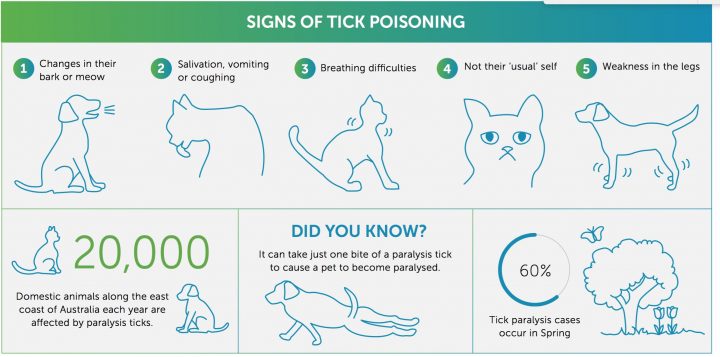The simple tips that could save your pet’s life

As the weather warms up, so too do the dangers lurking in your backyard for your pets.
Spring and summer are ripe for a number of nasty things that can kill your pet, but the worst of all is perhaps the smallest – ticks.
Just ask Gold Coast pet owner Pam.
Her Golden Retriever Baxter picked up a tick two years ago during tick season and became ill.
Pam described Baxter’s brush with a tick as “traumatic”.
“He had this thing that looked like broken skin near his eye,” she recalled.
“In the back of my mind I wondered whether it was a tick.”
By later in the evening the tick had exploded in size – and Pam knew then it was a tick.
“It was very large,” she said.
“We raced down to the emergency vet so they could remove it.
“They kept a close eye on him, he lost all his beautiful Golden Retriever locks but he didn’t have any other ticks on him which was good.”
Luckily Baxter made a full recover, but Pam didn’t take his recovery for granted.
You might be wondering what she does now to keep him tick free?
Well, she uses a few simple tips to keep an eye on him.
“Ever since Baxter got a tick I’ve been very aware of the need to keep on top of the preventative side of things,” she said.
“I think especially in tick season you should be very zealous in your application of whatever you use.”
Pam switched from a liquid application to a tick collar.
But that’s not all she does.
She also regularly baths Baxter, has him clipped during the warmer months and she also gives him regular inspections to check for any ticks.
According to the experts, taking preventative measures like Pam can save your dog’s life.
Technical Services Vet Dr Liisa Ahlstrom, who works with pet care company Bayer, said it was important for pet owners to recognise the early warning signs of tick paralysis.
“The sooner you can find and remove the tick, the better,” she said.
“Your pet can go downhill really fast with tick paralysis.”
Some of the early symptoms Dr Ahlstrom recommends you keep an eye on include:
- Your pet being quieter than normal, not barking or meowing as much
- Changes in the sound of your pet’s bark or meow
- Reduced appetite
- Change in breathing – breathing faster or breathing difficulty
- Coughing, retching or vomiting

Source: Bayer
And the biggest symptom to look out for – wobbly legs.
Dr Ahlstrom said wobbliness in the back legs should trigger a warning bell.
“They can end up completely paralysed in their back legs,” she said.
“This paralysis can work its way up the body and affect the muscles they need for breathing – it’s quite deadly and actually often fatal.”
So you know what to look for?
But what can you actually do to stop your dog from getting a tick in the first place?
Dr Ahlstrom recommends the best thing you can do for your pet is to use a tick prevention product.
“You should look for a product that repels ticks or kills them on contact,” she said.
“Make sure you’re reapplying or using that tick prevention product as directed.”
There are a range of products on the market from spot-on treatments such as Advantix to tick collars that offer lasting protection for months such as Seresto.
But you shouldn’t rely solely on any product.
“The thing to keep in mind is no product is 100% effective,” Dr Ahlstrom said.
“You should check your pets for ticks everyday.
“Feeling their skin with your finger tips is the best way to find a tick, often you won’t see them through their hair.”

Source: Bayer
Vets recommend you concentrate on the head and neck of your dog when looking for ticks.
“80% of ticks are found on the head and neck, 20% are found elsewhere on the body,” Dr Ahlstrom said.
“It’s important to remove the tick as soon as possible by the grasping the tick as close to the skin as you can and twisting it as you pull.”
Even after removing the tick, vets suggest keeping an eye on your pet.
It turns out, that even if your pet doesn’t show any symptoms it can still become ill.
“We tend to see pets can deteriorate and go downhill, even two days after you’ve removed the tick,” Dr Ahlstrom said.
“If you have a removed a tick and your pet is showing any symptoms at all, talk to your vet or take them into the vet.
“If they don’t show any symptoms, don’t be complacent – keep a close eye on them.”
These simple tips could save your pet’s life, and save you from thousands of dollars in vet bills.
Has your pet ever had a tick before? What do you do to prevent you pet from getting ticks?








 Proudly Australian owned and operated
Proudly Australian owned and operated